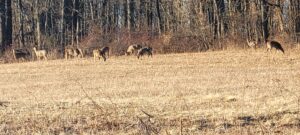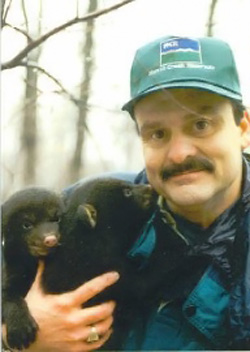MCR Monthly Newsletter
What’s Hatchn’ing at Merrill Creek Reservoir with Ranger Rich

About the Author: Richard Dansen Sr.
Rich has a bachelor’s degree in Environmental Science with a concentration in zoology and wildlife management. Rich has been with Merrill Creek Reservoir since 1995 where he teaches environmental education.
You can find Rich each weekend at the MCR visitors center talking about the wonderful wildlife and habitats of MCR. Stop by to say hi!
“In writing this monthly newsletter, I hope to inform and educate readers about some of the wonderful and fascinating events going on in nature at Merrill Creek Reservoir each month. Enjoy!”
– Ranger Rich
January 2026
White-tailed deer (Odocoileus virginianus) can survive cold winters because they have evolved various physical adaptations. One such adaption is having darker hollow hair fur in their winter coat. Darker oily fur absorbs more sunlight (i.e. warming the fur) and the hollow hairs insulate and help retain more body heat. This, combined with storing fat in the fall, helps them survive extreme cold.
Some other adaptions are that deer hooves are made of keratin with no nerve endings (much like your fingernail which doesn’t feel pain when you cut it). The lower leg has minimal muscle and is mostly tendon and bone therefore, needing very little blood flow. Additionally, with something called countercurrent heat exchange, the arteries carrying warm blood from the body core run close to veins carrying cool blood back from the feet. The warm arterial blood transfers its heat to the cold venous blood warming it as it returns to the body, thus helping to maintain a warm body core temperature. Their feet do get cold, but body core temperature is most important! These features allow deer to walk in deep snow and ice without getting frostbite.
White-tailed deer are capable of reproducing at a rate that often exceeds their local food supply capacity (carrying capacity) leading to overpopulation. Overabundant white-tailed deer populations can significantly damage natural habitats by over-browsing native plants, preventing forest regeneration, reducing biodiversity, promoting invasive species and impacting other wildlife that rely on a healthy understory for food and shelter. While deer are a part of the natural ecosystems, their unchecked numbers are often due to a lack of natural predators like wolves, coyotes, bear, and mountain lions. This lack of predation can lead to unhealthy forests where few natural plants can survive. Deer overpopulation can also result in an increase other negative impacts such as spreading tick bourse diseases such as Lyme-disease and a possible increase of the very serious Chronic Wasting Disease (CWD) in deer herds.
 At MCR, white-tailed deer have devastated our forest resources and have altered vegetation structure and species composition. The overabundance of deer and the browse that goes along with it, combined with other ecological factors, (i.e. disease, invasive insects, exotic vegetation growth and the lack of light reaching the forest floor because of overstocked closed canopy forests), have destroyed critical habitat for many other species that live (or once lived, such as the Ruffed Grouse) at MCR.
At MCR, white-tailed deer have devastated our forest resources and have altered vegetation structure and species composition. The overabundance of deer and the browse that goes along with it, combined with other ecological factors, (i.e. disease, invasive insects, exotic vegetation growth and the lack of light reaching the forest floor because of overstocked closed canopy forests), have destroyed critical habitat for many other species that live (or once lived, such as the Ruffed Grouse) at MCR.
MCR conducts annual deer densities surveys and jawbone-teeth aging examinations from harvested deer, as well as works with USFWS, NJDFW, and science-based conservation organizations in an effort to understand and better balance white-tailed deer densities at the property. MCR also implements a NJ State Approved Forest Stewardship Plan, native planting projects and other conservation practices and prescriptions to restore or enhance habitat at the property. However, regulated hunting is one of the most effective tools that is used to address the overpopulation of a species, as it is an adaptive resource management process when coupled with using sound conservation research methods, principles and practices.
Happy Holidays and stay safe!
Ranger Rich
Merrill Creek Reservoir
34 Merrill Creek Road
Washington, NJ 07882
(908) 454-1213 (ph)
(908) 454-2747 (f)
*Play MCR's Tree Finder Game !
Along the trails at MCR there are 9 different individual trees that have FACES. More Info...



